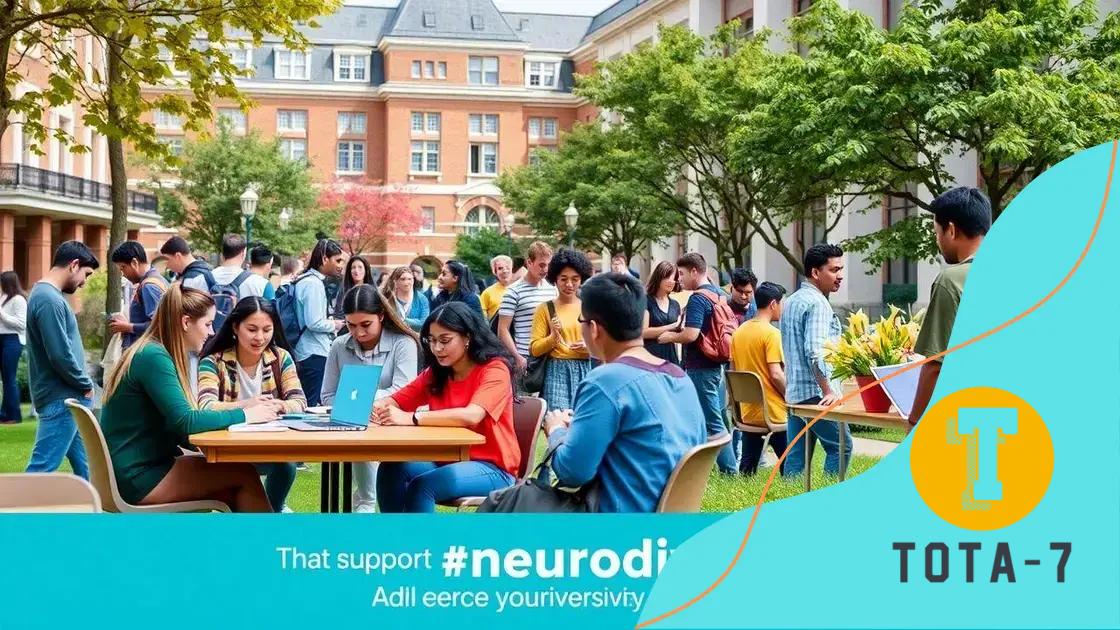Neurodiversity inclusion policies emerge in higher education

Neurodiversity inclusion policies emerge in higher education to create supportive environments for neurodiverse students, focusing on technology integration, mental health resources, and evolving policies for equitable learning experiences.
Neurodiversity inclusion policies emerge in higher education as institutions strive for equity. Have you noticed how these policies can transform the academic experience for many students? Let’s dive into how these initiatives are reshaping our learning environments.
Understanding neurodiversity in academic settings
Understanding neurodiversity in academic settings is crucial for creating an inclusive environment. This term refers to the variety of neurological differences among individuals, such as autism, ADHD, and dyslexia. Recognizing these differences helps institutions support all learners effectively.
Why Recognizing Neurodiversity Matters
Embracing neurodiversity in education can change lives. It fosters an atmosphere where every student’s unique strengths are valued. This approach challenges traditional views and highlights the importance of tailored learning experiences.
- Encourages unique perspectives in discussions.
- Promotes creativity and problem-solving skills.
- Builds a supportive community among students.
- Helps faculty understand diverse learning needs.
In an academic environment, understanding neurodiversity means adapting teaching strategies to meet varied needs. For example, flexible deadlines and alternative assessment methods can help students thrive. Creating such conditions not only aids learning but also boosts confidence.
Methods of Support
Various techniques can be employed to support neurodiverse students effectively. Institutions can implement measures such as:
- Training for educators on neurodiversity.
- Creating quiet spaces for focused work.
- Offering mentor programs that connect students.
Moreover, engaging students in conversations about their needs plays a significant role. By fostering open communication, schools and colleges can adapt more easily to diverse learning styles.
As we move forward, it’s vital for academic institutions to prioritize neurodiversity inclusion. This not only prepares students for a diverse workforce but also enriches the educational experience for everyone involved.
Why inclusion policies matter for higher education

Inclusion policies are vital in higher education because they create a leveling field for all students. When universities adopt these policies, they open doors for everyone, especially those with neurodiverse conditions. A commitment to inclusion not only enhances learning opportunities but also enriches the entire academic community.
The Benefits of Inclusion Policies
Implementing inclusion policies in academic environments brings numerous advantages. These advantages are felt by both students and institutions:
- Helps to create a sense of belonging among students.
- Encourages diverse viewpoints and ideas.
- Reduces instances of bias and discrimination.
- Promotes better academic performance.
Inclusion benefits everyone. When students feel accepted and valued, they are more likely to participate actively in class discussions. This participation enhances critical thinking and boosts creativity across the board.
Addressing Challenges
While the benefits are clear, there are challenges in implementing these policies. Institutions must work to identify and overcome barriers such as:
- Lack of awareness about neurodiversity.
- Insufficient training for faculty and staff.
- Limited resources for student support services.
To effectively address these challenges, it is essential that universities commit to ongoing education and training. Awareness programs can help faculty better understand neurodiversity and how to support all learners effectively.
Ultimately, by prioritizing inclusion policies, higher education institutions not only comply with legal obligations but also foster an environment that celebrates diversity. This commitment allows them to adapt more effortlessly to the needs of all students, ensuring that everyone has a fair chance to succeed.
Practical steps for implementing inclusion strategies
Implementing inclusion strategies in higher education requires careful planning and dedication. Institutions need practical steps to ensure that every student, especially those who are neurodiverse, feels valued and supported. By taking strategic actions, schools can create an environment conducive to learning for everyone.
Assessing Current Practices
The first step is to evaluate existing policies and practices. Understanding what currently works and what doesn’t is essential. Here are important aspects to consider:
- Gather feedback from students regarding their experiences.
- Analyze academic performance data to identify gaps.
- Review support services available for neurodiverse students.
By assessing these areas, institutions can pinpoint specific needs and areas for improvement.
Creating an Inclusive Curriculum
Next, developing an inclusive curriculum is vital. Educators can incorporate diverse teaching methods that cater to different learning styles. This flexibility ensures that all students engage with the material effectively. Key strategies include:
- Using multimedia resources to appeal to visual learners.
- Offering group projects that promote collaboration.
- Implementing adaptive technology for accessibility.
Besides adapting the curriculum, training staff and faculty is crucial. Educators need the tools and knowledge to support diverse learners. Regular workshops can help faculty understand neurodiversity and effective teaching strategies.
Further, institutions should establish mentorship programs that connect students with peers and faculty mentors. This connection can provide the guidance and encouragement necessary for success.
Lastly, fostering an inclusive community requires ongoing involvement. Regular events and awareness campaigns can help promote understanding and support among students.
Success stories from universities

Success stories from universities illustrate the positive impact of neurodiversity inclusion policies. These examples show how institutions can create better learning environments for all students. By focusing on innovative strategies and support systems, universities have transformed their campuses into more inclusive spaces.
Case Study: University A
At University A, the implementation of an inclusive curriculum has led to remarkable outcomes. Faculty members collaborated to develop courses that incorporate various teaching methods. Students reported feeling more engaged and understood. This approach has resulted in higher academic performance and fewer dropouts.
Peer Mentorship Programs
Another powerful initiative comes from University B, which launched a peer mentorship program specifically for neurodiverse students. This program matches mentors with mentees, providing guidance and support. Research shows that students participating in this program have improved their social skills and academic success.
- Mentors provide personalized support.
- Students gain confidence in social settings.
- Academic performance improves through individualized guidance.
Such mentorship fosters a sense of community, encouraging students to connect and share their experiences.
Engaging Workshops at University C
University C hosts engaging workshops aiming to raise awareness about neurodiversity. These workshops educate faculty and students about diverse learning needs. Feedback has shown that participation leads to better understanding and acceptance among peers, enhancing the overall campus atmosphere.
Through these initiatives, universities demonstrate how effective inclusion policies can positively affect student experiences. The ongoing commitment to inclusivity inspires other institutions to adopt similar strategies, aiming for a more equitable future for all learners.
Future trends in neurodiversity advancement
Future trends in neurodiversity advancement promise exciting changes in higher education. As awareness grows, more institutions are adopting inclusive practices that cater to diverse learning needs. This shift will shape how educational systems operate and how they support all students.
Technology Integration
One major trend is the integration of technology to assist neurodiverse learners. Advanced tools can help students with various needs in significant ways. For example, apps that convert speech to text or programs that organize information visually can enhance learning experiences.
- Utilizing virtual reality for immersive learning experiences.
- Implementing AI-driven tutoring systems.
- Adapting online platforms for better accessibility.
As technology continues to evolve, it will provide new opportunities for engagement and understanding in the classroom.
Focus on Mental Health
Another trend is the increasing focus on mental health resources. Many universities are recognizing that supporting mental health is vital for success. Institutions are introducing more counseling options and stress management workshops aimed at neurodiverse students. This emphasis helps create a healthier learning environment.
In addition to traditional resources, peer support groups and mental health awareness programs are becoming common. These initiatives allow students to connect and share their experiences, fostering a supportive community.
Policy Evolution
As the demand for inclusive practices rises, policies will continue to evolve. More universities will likely implement clear guidelines for neurodiversity inclusion. This evolution may lead to more accountability and better support systems across campuses, ensuring that no student is left behind.
The future of neurodiversity advancement in higher education looks promising, driven by technology, mental health support, and evolving policies. These trends not only benefit neurodiverse students but enrich the educational experience for everyone.
neurodiversity advancement in higher education is bright and full of potential. Universities are making significant strides in creating inclusive environments for all students. By focusing on technology, mental health, and evolving policies, educational institutions can ensure that everyone has the opportunity to succeed. Continued awareness and commitment to these efforts will benefit not only neurodiverse learners but also enhance the learning experience for all students. Together, we can foster a more inclusive and understanding academic community.
FAQ – Frequently Asked Questions about Neurodiversity Inclusion in Higher Education
What are neurodiversity inclusion policies?
Neurodiversity inclusion policies are guidelines that promote understanding and support for students with different neurological conditions, ensuring an equitable learning environment.
How can technology assist neurodiverse students?
Technology can provide tools like speech-to-text software and interactive learning platforms, making education more accessible for neurodiverse learners.
Why is mental health support important in universities?
Mental health support is crucial as it helps students manage stress and anxiety, leading to better academic performance and overall well-being.
What future trends can we expect in neurodiversity advancement?
Future trends may include increased technology integration, a stronger focus on mental health resources, and evolving policies that ensure inclusivity in educational settings.





